|
|
I don’t know if two weeks in the solace of the mountains has re-sensitized me to train horns, or if it’s my imagination, but the night time horn blowing of BNSF trains passing through south Richmond seems to be getting worse, starting earlier and lasting longer. Fortunately, some relief may be near. Assistant City Attorney Carlos Privat emailed me on August 16:
West 4 [Quiet Zone] – Necessary infrastructure work at the West 4 quiet zone crossings (2nd and 3rd) is underway. I have an inquiry into BNSF concerning their timing. I believe the work should be completed and a quiet zone established by the end of September but I will let you know if I hear anything to the contrary.
In the Marina Bay area, a private crossing at Meeker Avenue has been a real headache (earache?), but appears to be near a solution:
All Aboard Storage (Meeker Ave) – We met with the PUC, property owner and BNSF on August 3 to finalize the improvements necessary to silence the train horns at the private crossing located at the All Aboard Storage facility. The PUC is requiring we install gates, flashing lights, wayside horns and modify the design of the driveway by moving the keypad to the right side of the driveway. With these improvements, the PUC will permit, and BNSF has agreed to, use the wayside horns in place of the train horns. BNSF is preparing an estimate for the railroad related work and has informed me the estimate should be ready within the next two months. Steven Tam and Joel Camacho with the Engineering Department are coordinating this work and will be handling the purchase and coordination of the wayside horns.
In response to appeals for relief at the Cutting grade crossing near Carlson, which is Union pacific, not BNSF, Privat wrote:
As mentioned this afternoon, there are no current plans to establish a quiet zone at the Cutting and Carlson crossing. The last time staff looked into creating a quiet zone at that crossing the Quiet Zone Risk Index was above the Nationwide Significant Risk Threshold. Since then, however, the Engineering Department has been actively pursuing safety improvements to the crossing and is in the process of designing those improvements now. The improvements will include replacement of the existing traffic signal system, extending medians and constructing sidewalks. Staff anticipates the design will be complete and out to bid in early 2011 and that construction will be completed by the end of 2011. Once the improvements are completed, the crossing may qualify for a quiet zone. Even if it does not, we will seek to use wayside horns as an alternative to train horns.
For some recent history, see:
I am reminding City staff that the City Council unanimously endorsed a study to “…determine the locations and costs of grade crossing improvements to all Richmond grade crossings in quiet zones.”
From the March 17, 2009, City Council Minutes:
In the matter to discuss and consider two considerations relative to the expansion of Burlington Northern Santa Fe (BNSF) quiet zones: (1) consider expansion of quiet zones to include the remainder of the BNSF trackage in south Richmond to include 3rd Street, 2nd Street, West Cutting Boulevard, Wright/Harbour Way South, Marina Way, and a private crossing to a storage facility; and (2) consider a study to determine the locations and costs of grade crossing improvements to all Richmond grade crossings in quiet zones. Councilmember Butt stated that expansion of the quiet zones to include the remainder of Burlington Northern Santa Fe trackage would prove beneficial to Richmond residents that live on the south side of Richmond. The total cost of the south Richmond quiet zones, excluding those already committed and/or funded by the City will be in the range of $750,000 and could come from a variety of sources, including State bond funds, Federal stimulus funds, Chevron’s $18 million settlement, conditions of development, CPUC, CalTrans 130 funds, etc. Naomi Williams, Jackie Thompson, Corky Booze, and Sherry Padgett gave comments. Councilmember Bates stated that there are higher priority matters in the City and stated he will not support the item. Following discussion, a motion by Councilmember Ritterman, seconded by Councilmember Viramontes, to approve the item by the following vote: Ayes: Councilmembers Butt, Ritterman, Rogers, Viramontes, Vice Mayor Lopez, and Mayor McLaughlin. Noes: Councilmember Bates. Abstentions: None. Absent: None.
Finally, a pertinent article from a July 2010 Contra Costa Times reminding us that noise is not just an urban aggravation; it can actually make us sick or even kill us.
Ear aches: Noise pollution rattles nerves, harms health
By Kathleen Kirkwood
Contra Costa Times correspondent
Posted: 07/25/2010 12:00:00 AM PDT
Updated: 07/25/2010 04:57:45 AM PDT
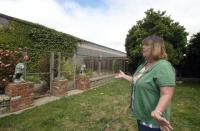 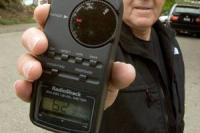 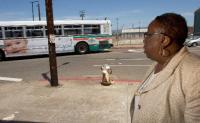 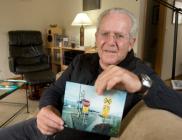 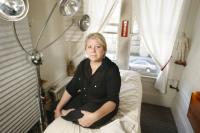
Nancy Culbertson won't sit in her Fremont backyard because of it.
It caused Oakland physician Louis Hagler's blood pressure to spike and marred his perfect health record.
Oakland acupuncturist Julie Laura Rose had enough of it, and packed up to move to Vallejo.
It's noise. Droning, piercing, incessant noise.
Even at night, cities and suburbs pulse with boom cars, alarms and trains.
Part of city living, right? Maybe so, but studies show the ruckus might be getting to us whether we know it or not.
High blood pressure, cardiovascular problems, sleeplessness, annoyance, diminished work production and poor school performance can result from prolonged exposure to noise, according to reports from the U.S.
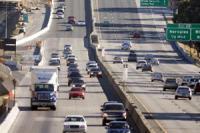
Traffic travels along Interstate Highway 80 through a construction zone near Rodeo, Calif., Wednesday, July 14, 2010. The most prevalent form of noise pollution is from automobile traffic. (D. Ross Cameron/Staff)
Environmental Protection Agency and the World Health Organization.
Despite mounting evidence that persistent, prolonged exposure to noise is bad for us, governments and lawmakers aren't doing enough to address it, said Hagler, 74, a retired physician who has spent the past decade researching the impacts of noise pollution.
"How do you convince people that secondhand noise is a problem? It's a lot like cigarettes were 20 years ago. It's spooky how similar it is," Hagler said.
Noise is overlooked in the same way secondhand smoke was once dismissed: Those who complain aren't taken seriously, even though health impacts have been documented, said Hagler, who co-authored a chapter on noise for "Emerging Environmental Technologies II," a recently released resource for policy makers and scientists.
Eardrums are also showing signs of duress. An estimated 15 percent of Americans between the ages of 20 and 69 have some kind of hearing loss due to noise exposure at work or play, according to the National Institutes of Health.
There are limits to what human hearing can handle. Sound is measured in decibels, and an increase of 10 means that sound is 10 times louder. A whisper is 30 decibels and a normal conversation 60 decibels. Prolonged exposure for eight hours at 85 decibels, such as city traffic or lawn equipment, is when hearing problems begin, the National Institutes of Health said.
There's also mounting evidence that points to noise increasing the risk of cardiovascular disorders, including hypertension and heart disease, according the World Health Organization. Last fall, WHO declared noise the biggest environmental nuisance facing Europe and issued night noise guidelines calling on officials to limit exposure to below 40 decibels -- corresponding to the sound from a quiet street in a residential area.
Sleepers exposed to higher levels over the year can suffer mild health effects, such as sleep disturbance and insomnia. Long-term exposure to levels above 55 decibels -- similar to the noise from a busy street -- can trigger elevated blood pressure and heart attacks, WHO said.
Noise takes a toll
Hagler didn't just happen upon the subject -- it was keeping him awake at night, literally. About 10 years ago, freight trains near his former Richmond home increased the frequency of their trips, and were blasting their horns at every crossing, day and night.
"It made me crazy every time I heard the noise," he said, "and my blood pressure went up."
A former U.S. Army medical officer, Hagler previously had a perfect health record. Suddenly he couldn't sleep and was taking blood pressure medication. Heart rate, blood pressure and breathing all increase when the system reacts to loud noises, he said.
"It became the fire in my belly and I decided to do something about it," he said.
After complaining to the Richmond City Council in 2001, Hagler found that other residents were fed up too. Their efforts led to Richmond becoming one of the first places in the country to take advantage of legislation allowing cities to establish "quiet zones" for train crossings, where horns aren't routinely sounded at every passing.
When Hagler moved to Oakland four years ago, he became interested in the issue of noisy "boom cars" and motorcycles. Although he's taken the issue to local police and the city council, Hagler admits he's yet to have an impact in the city. In Oakland, violent crime
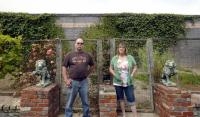
Bob And Nancy Culbertson in their backyard where a soundwall separates their property from Interstate 880 in Fremont, Calif. on Friday June 25, 2010. Years after they bought their Fremont home, Caltrans built this soundwall in their backyard when they expandedIinterstate 880. The Culbertsons have dealt with the extra noise by building into their home soundproofing improvements as they remodeled through the years. (Laura A. Oda/Staff)
and just keeping police ranks fully staffed top the list of concerns.
Oakland police try to respond to noise complaints about boom cars, barking dogs and other annoyances, but priorities must be made when resources are stretched, said Oakland police spokesman Jeff Thomason.
Margaret Gordon knows about noise. She lives and works in West Oakland, surrounded by three major freeways, BART tracks, the Port of Oakland and a bustling U.S. Post Office hub.
"The whole being is inundated by noise, it's everywhere," she said. "I've managed to adjust to it. But there's new people who move in and don't know about it. The real estate agent doesn't tell you about the noise."
Gordon, 63, is co-director for the West Oakland Environmental Indicators Project, which is targeting toxic pollution her neighborhood has been exposed to for decades. But she says noise is another irritant that agencies should address as well, because it affects quality of life just as much as other environmental harms.
"We are highly disturbed by the cumulative effects of noise," Gordon said. BART and its late-night and early morning trains have been a particular source of annoyance, especially when windows are open on hot nights, she said. "It's the sounds and vibrations of the trains."
Commuters are familiar with the earsplitting shriek that occurs when BART trains encounter rippled tracks and metal meets metal. The agency has two "grinders" in constant use, smoothing the rails where there are the most noise complaints. That's usually in the Transbay Tube, said Luna Salaver, BART public information officer.
"Basically when trains go over the rails, it causes ripples and that's what causes the whine," Salaver said.
"Big city" noises such as BART and the whine of traffic aren't the only stressors. Even in the suburbs, leaf blowers and lawn mowers take their toll.
"There's a high-frequency pitch unique to leaf blowers that makes them more annoying, and they are revving them up all the time," said Peter Kendall, 52, a semiretired bond trader who founded Quiet Orinda last year with his wife Susan.
The group has been gathering signatures in hopes of persuading the Orinda City Council to ban the machines. Kendall and his supporters haven't revealed how many signatures they have so far, or when they plan to present them to the city.
The Kendalls say they have also begun researching the impacts of dust and pollution kicked up by the leaf blowers as an alternative strategy for fighting them. The air pollution argument carries more teeth with lawmakers, they say, than arguments about the effects of constant noise.
Dr. Michael Kron, a psychiatrist supporting Quiet Orinda, said the leaf blower noise is a serious issue for those trying to work at home or catch sleep during the day.
"Noise doesn't have to be persistent, it just has to be out of your control and intermittent," said Kron, who has a practice in Walnut Creek. There's a reason that noise is used in battle to subdue the enemy, he said. "It's been weaponized."
And for those who have no control over noise that's bothering them, a "learned helplessness" creeps in, Kron said.
Driven away by noise
Not everyone annoyed by noise sticks around for it. According to the 2000 U.S. Census, 30 percent of Americans have complained about noise. Among those who complained, nearly 40 percent wanted to move because of it.
Rose, an Oakland acupuncturist, is one of them. She recently decided to pack up after 13 years in an older apartment building near Lake Merritt. She loves her home and the neighborhood, near Adams Point, a new Whole Foods and Oakland cathedral.
But Rose, 53, is planning to flee with her cat and dog to a house in Vallejo this month to get away from the noise of idling diesel trucks, vans, car alarms and regular mobile shredding operations at an office across the street.
She finds herself cringing at the din and automatically counting when car alarms go off -- she knows exactly how long they will last.
"My nervous system reacts and shoulders and ears tense up," she said.
Rose rarely listens to music or television anymore. She's become hypersensitive to sounds. "I have to filter my noise and decide when I let it in."
Rose maintains noise from trucks and other engines is bouncing off the windows of an office building opposite her Oakland apartment and bombarding her with noise.
Ray Derania, Oakland's director of building inspection services, that he's not certain if that is the problem, but that said "rebounding" sound can sometimes focus on a particular spot.
One of the Oakland's chief noise issues has to do with older housing stock, built close together before modern setbacks and clearances were in place, Derania said.
"We've got condos and apartment buildings that were built in the '20s and '30s," Derania said. Fewer people and automobiles in those years made for quieter apartment living.
"Noise has now become a quality-of-life issue," he said.
'We're stuck with it'
Adjusting to nearby noise has become second nature for Culbertson, a 61-year-old resident of Fremont's Glenmoor neighborhood, next to an Interstate 880 sound wall.
Although the walls, up to 16 feet tall, were meant to muffle noise, Culbertson said they no longer block the freeway roar, mostly because traffic never seems to let up. Rush-hour lasts all day long and into the evening, she said.
"I just don't go out back," Culbertson said. "Before, when I lived in San Jose, I would go outside and sit and read. I enjoyed hearing the birds or a dragonfly would buzz by."
The noise keeps her from using her backyard and opening windows, Culbertson said.
She moved there three decades ago, before the 1989 freeway widening project began, adding a lane and sound walls. Before the project, a thick jungle of trees and shrubs had blocked the sight and muffled sounds from the freeway, Culbertson said.
Caltrans conducted several meetings and concerns were expressed about the project back in the 1980s, about both air and noise pollution. Thus Culbertson said complaints about noise now seem futile. "We're stuck with it," she said.
Noise is always going to be a part of city life, but controlling exposure to it can be managed through legislation and technology, Hagler said.
In the U.S., the Noise Control Act of 1972 and the Quiet Communities Act of 1978 are still on the books but unfunded. The federal Office of Noise Abatement and Control's funding ran out in 1982, shifting regulation responsibilities to state and local agencies.
During 10 years of operation under the U.S. EPA, the federal noise office and the legislation had funded research, laid down noise regulations, published public health criteria and even sponsored an international conference.
California established its own noise office, under the California Department of Health Services, in 1973, with the goal of assisting local governments with noise abatement procedures. Guidelines were issued, but funding for the office ran out in 1994.
In recent years, Web sites, such as the Noise Pollution Clearinghouse at www.nonoise.org and NoiseOFF, www.noiseoff.org, have sprung up, trying to increase awareness of the issue and providing information about noise exposure, ways to get noise regulations strengthened or enforced and listing resources to make urban living quieter, such as using acoustical building materials and window treatments.
Noise has been long been recognized as intrusive, Hagler said, but we need to become smarter about how we manage it. who also co-authored an article with his late wife, registered nurse Lisa Goines, in March 2007 for the Southern Medical Journal titled "Noise Pollution: A Modern Plague."
"The goal is not to create a silent world," he said. Many sources of loud sound are tolerated because they are deemed necessary, such as household appliances and emergency sirens, he said. But many more, such as from boom cars and deafening noise at sporting events and concerts, are considered noise because they come from unwanted sources.
There's a difference between the noise of a bus going by and boom car. "One serves a purpose and one is self-aggrandizing," Hagler said.
Health professionals must lead the way, Hagler said, by pointing out the impacts of too much noise. Improved local regulations and active enforcement of existing laws is needed.
"We just have to get smart about secondhand noise," he said, "and turn down the volume a little."
HEAR THIS
Decibel levels of common sounds:
· Normal breathing: 10
· Whisper: 30
· Refrigerator humming: 40
· Quiet office: 50 to 60 (Comfortable hearing levels are less than 60 decibels.)
· Average city traffic, garbage disposal: 80 (Constant exposure may cause hearing damage.)
· lawn EQUIPMENT: 85 to 90 (Eighty-five decibels is the level at which hearing damage begins with prolonged, eight-hour exposure.)
· Subway: 88
· Symphony orchestra: 110 (Regular exposure to sound over 100 decibels for more than one minute risks permanent hearing loss.)
· Rock concerts: 110 to 140 (Threshold of pain begins around 125 decibels.)
· Jet engines (near): 140
· loud car stereos: 145
Details: A noise meter with common sounds can be found at www.cdc.gov/niosh/topics/noise.
Source: National Institute on Deafness and Other Communication Disorders
Online: Read more about an Orinda couple's effort to ban leaf blowers in the city at ContraCostaTimes.com.
|






